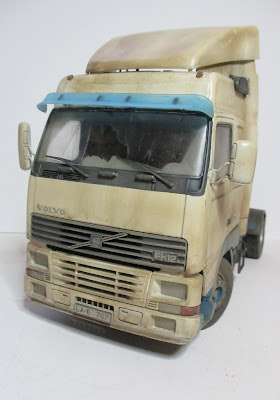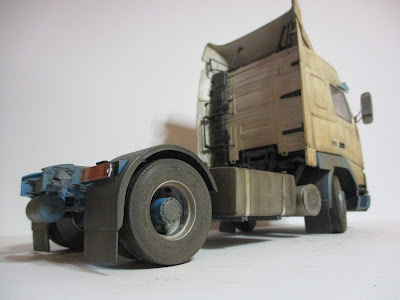A gap of a couple of days since the last post as I have literally been watching dry on the K5350 Mustang Truck. Well there has also been some work on getting the last pieces of the cab fitted so it can be painted up but a lot of time has been taken up in applying 'washes' to the chassis and cargo body. I use very diluted brown and grey Vallejo paint. This is then painted on to the model and then I let gravity takes its course as the paint pigment gets trapped in nooks and crannies of the model as well as dulling the overall paint finish. As it is very dilute it does take a long time to dry hence you feel as though you are sat there watching paint dry. Its all very therapeutic though and you can get lost in time if you decide to intervene on gravity's effects by using the paint brush to start making streaking effects or adding paint here or taking it away from somewhere else. The idea however is to make the truck look well used - no shampoo and wax every Sunday for a working truck like this! In essence applying a dilute coat of paint like this is trying to emulate the environment the vehicle drives through. Take a car out on a wet day and it comes back home looking dirty. Rain itself contains dirt, the spray off the road has dirt and even the air itself can have dirt in it. All of this dirt just loves to deposit itself on vehicles - especially if you have just washed it! Something I have explained to Mrs. Woody on many occasions when she has deemed her car needs washing and I have tried to get out of it by pointing out that it will only get dirty again. Never works!
The cargo body started out looking like this
and now looks like this
Still a way to go but you can almost feel that ingrained grime on the paintwork.
Whilst I was waiting for the paint to dry I did have a look at some of my previous cherished models or as Mrs. W would say junk, which are beginning to reside on the shelves in the man cave AKA the Room of Gloom. Built about 18 years ago this is an Italeri 1/24 scale DAF 95XF Super Cab. It was a simple build as there was no engine to construct and it was one of Italeri's first ventures into their 'New Concert' of simplified truck kits. There were a few others but they were not popular with modelers and I am pleased to say all the new releases over the past few years have been full kits with engines and gearboxes.
Its hitched up to an Italeri Schmitz Dumper Trailer which is an impressively big model. Built in 2013 I recall managing to build the majority of the kit in a day! Wow! If only I could do that now. I can see from the photo that I need to get the duster out. Unlike the K5350 Mustang Truck this truck and trailer are cared for!
Right back to the paint drying channel!























































